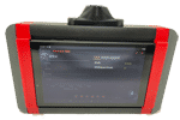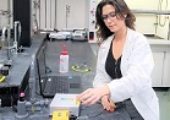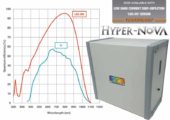 K. Chao, X. Nou, Y. Liu, M. S. Kim, D. E. Chan, C.-C. Yang, J. Patel, M. Sharma
K. Chao, X. Nou, Y. Liu, M. S. Kim, D. E. Chan, C.-C. Yang, J. Patel, M. Sharma
Visible and near infrared (NIR) spectra and samples for laboratory microbial analysis were acquired of fecalcontaminants, ingesta contaminants, and bare processing equipment surfaces (rubber and stainless steel) in a commercial poultry processing plant. Spectra were analyzed in the visible region of 450 to 748 nm and the NIR region of 920 to 1680 nm and microbial sampling for Enterobacteriaceae counts (EBC) was conducted for 82 fecal contaminant samples, 59 ingesta contaminant samples, 40 bare rubber belt areas, and 40 bare stainless steel areas. Two wavelength band ratios in the visible and NIR regions were selected for separating contaminants from equipment areas. Principal component analysis (PCA) was performed to analyze the spectral data set and 2 class soft independent modeling of class analogy (SIMCA) models were developed for comparison with band ratio classification. Fecal and ingesta contaminants were difficult to separate from each other but both were easily differentiated from the equipment areas. The visible ratio using 518 and 576 nm correctly classified 100% of contaminant samples and 92.5% of equipment area samples. The NIR ratio using 1565 and 1645 nm correctly classified 100% of the contaminant samples and 95% of the equipment area samples. Microbiological analysis found the highest EBC levels for fecal contaminants; mean EBC for ingesta contaminants was significantly lower than that for fecal contaminants. The high EBC levels for fecal contaminants indicate that these contaminants should be targeted for spectral based detection methods for sanitation monitoring and verification purposes; although their EBC levels are significantly lower, ingesta contaminants should also be included due to difficulty of separation from fecal contaminants.

Two portable battery powered spectrometer systems were used to collect the reflectance spectra in the visible (400-900 nm) and NIR (900-1700 nm) regions (fig. 1). For measuring visible spectra, a EPP2000-CXR (now BLACK-Comet CXR) spectrometer was used with an SL1 tungsten-krypton fiber-optic light source. For measuring NIR spectra, a EPP2000-InGaAs spectrometer (now RED-Wave Spectrometers) was used with a duplicate SL1 light source unit and a bifurcated fiber-optic probe





